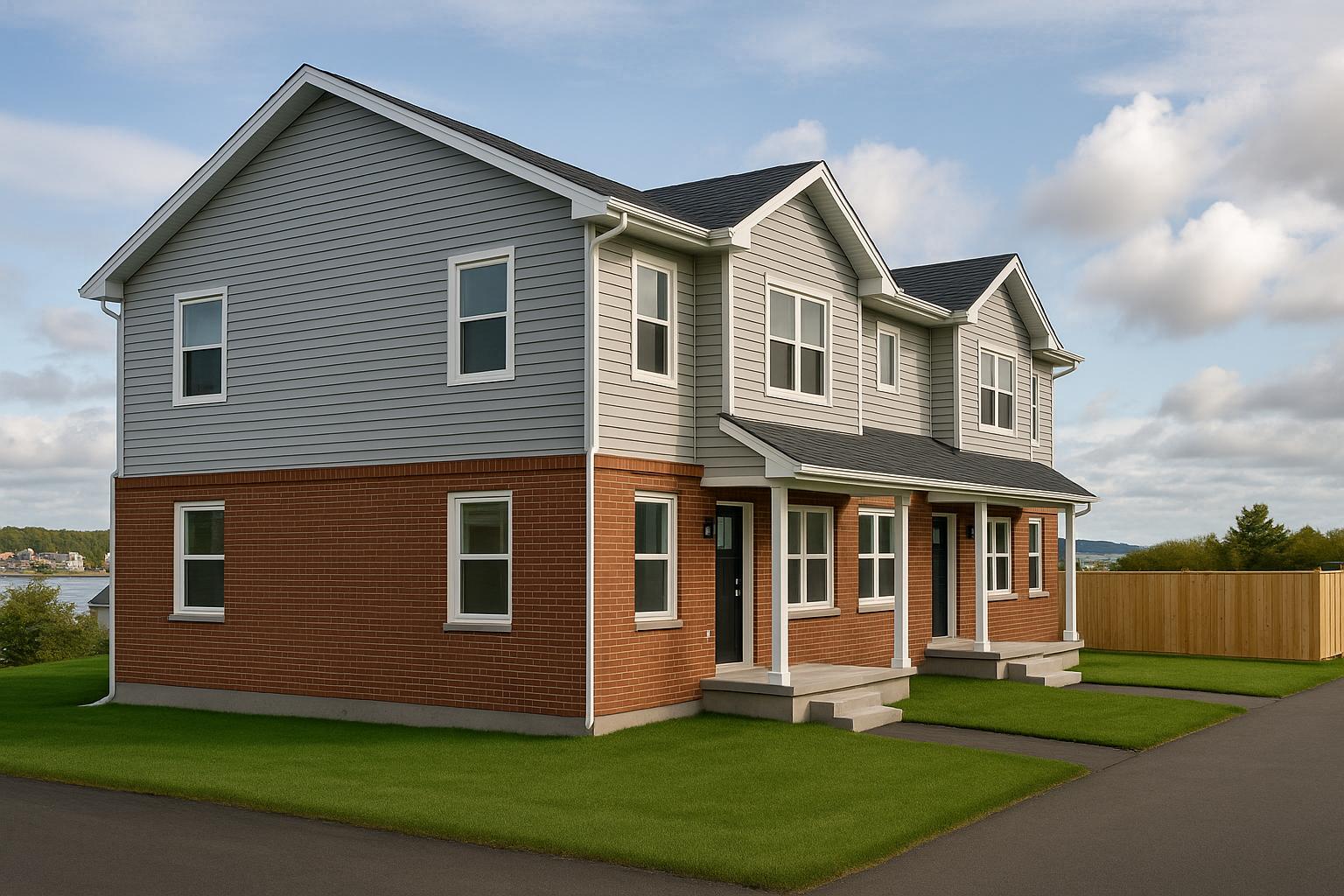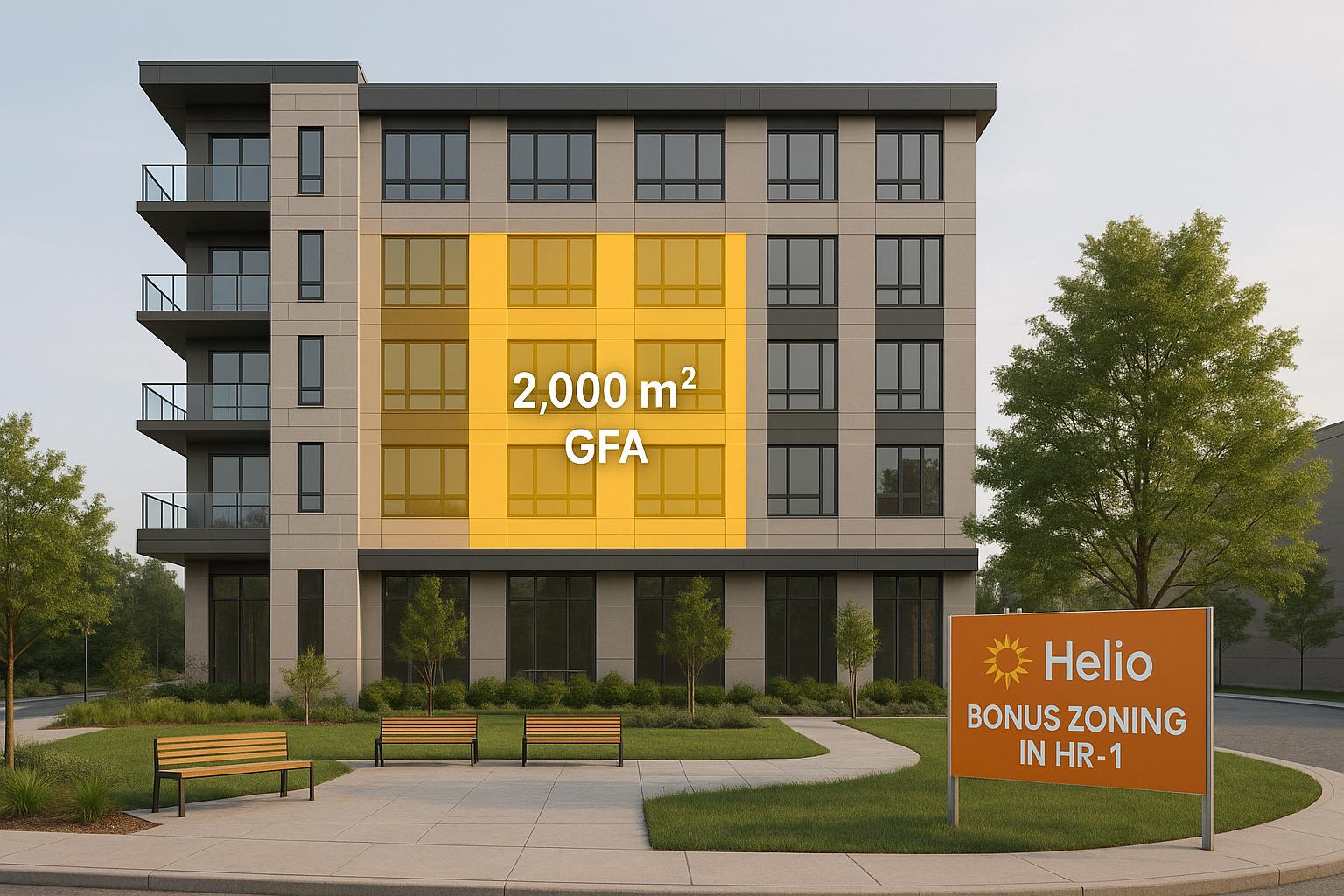Halifax’s ER-3 zoning is reshaping how small multi-unit rentals are designed. The two major updates - an 11-metre building height limit (plus 3 metres for roof elements) and the removal of minimum parking requirements - are reducing construction costs and increasing rental potential. Here’s what you need to know:
- Height Limit: Buildings can now reach 14 metres in total, allowing for three full storeys and flexible roof features.
- No Parking Requirements: Developers no longer need to allocate space for parking, freeing up land for more units or amenities.
- More Units, Lower Costs: Higher density and no parking mandates mean better use of land, reduced expenses, and improved rental income.
- Neighbourhood Fit: Designs should balance density with the surrounding area’s character, using setbacks, roof designs, and facades to blend in.
- Efficient Construction: Integrated design-build approaches simplify the process, offering fixed costs ($160,000/unit) and faster timelines (6 months).
With Halifax facing a housing shortage, ER-3 zoning offers a practical way to create medium-density housing while maximizing returns for developers. Partnering with experienced builders is key to navigating these opportunities effectively.
HALIFAX Home Owners May Have Just Won THE LOTTERY : Halifax Proposed Zoning Changes January 2024
New Building Height and Parking Rules
Halifax's ER-3 zoning introduces two key updates that shape multi-unit developments, offering fresh opportunities to make better use of space and improve project returns.
New Height Limit: 11 m Plus 3 m for Roof
Under the ER-3 zoning rules, buildings can rise up to 11 metres for the main structure, with an extra 3 metres allowed for roof elements. This gives a total height of 14 metres, providing flexibility for creative designs.
This new height allowance makes it possible to plan for three full storeys instead of being restricted to two and a partial third, while still maintaining comfortable ceiling heights. The additional 3 metres for the roof can accommodate essential features like mechanical systems, elevator shafts, or stairwell access. Beyond functionality, this space can also be used for rooftop terraces or shared amenity spaces, adding value without sacrificing interior layouts. The increased height works hand-in-hand with the updated parking rules, expanding design possibilities even further.
No Minimum Parking Required
The removal of mandatory parking requirements is a game-changer for site planning and costs. Previously, zoning regulations often required a set number of parking spaces per unit, which took up valuable land.
Now, with no minimum parking rules, developers can use that space more creatively, increasing unit density and improving land use efficiency. This also cuts down on construction expenses by eliminating the need for parking infrastructure. In areas with good transit options and walkable amenities, tenants may not rely as much on personal vehicles, allowing property owners to adjust parking availability based on actual demand rather than outdated zoning mandates.
How ER-3 Rules Affect Building Design
Halifax's ER-3 zoning has introduced changes that directly influence building design by increasing height limits and removing parking requirements. These updates pave the way for higher density and more efficient use of space, allowing for greater functionality and improved project outcomes.
Fitting More Units on Your Lot
With the new height allowances and the elimination of parking mandates, it’s now possible to reimagine how space is used on a lot. In traditional two-storey designs, a portion of the lot was reserved for parking, limiting the area available for additional units or amenities. Under ER-3, this restriction is gone, freeing up space that can be used for more rental units, green spaces, or other outdoor features. This shift not only increases the number of units but also enhances the financial viability of a project.
The added height allowance supports the construction of efficient three-storey buildings, offering more flexibility in design. These taller structures can accommodate more units while maintaining a compact footprint, which helps improve rental returns and overall project economics.
However, while density is important, the design must still align with the surrounding neighbourhood's character.
Building Design That Fits the Neighbourhood
For ER-3 projects to succeed, they need to balance increased density with neighbourhood compatibility. Thoughtful facade designs and building massing can ensure that taller buildings blend into the streetscape. For instance, setting the top floor back from the main facade can soften the visual impact of a taller structure, making it more harmonious with nearby two-storey homes.
Roof design is another key consideration. The additional 3 metres of height can be used for features like peaked roofs, which help taller buildings integrate more naturally with the architectural style of the area. This extra space can also be utilized for shared amenities, such as rooftop decks or storage areas, adding value for tenants without increasing the building's footprint. These design choices not only allow for more units but also ensure the building complements the surrounding environment.
Strategic roof and window designs can further enhance natural light and maintain a sense of compatibility with the neighbourhood.
Site Layout Examples for ER-3 Projects
Efficient site layouts are crucial for maximizing both density and liveability. Configurations like fourplexes, L-shaped, or U-shaped layouts make excellent use of available space while providing room for outdoor amenities. Fourplex designs work particularly well on corner lots or sites with good lane access, where the entire lot can be optimized for building placement and outdoor living areas.
For larger projects, L-shaped or U-shaped layouts are ideal for six- to eight-unit buildings. These layouts can create private outdoor spaces within the lot while adhering to setback requirements. They also offer a mix of ground-floor units with private entrances and upper-level units accessible through shared entryways.
Townhouse-style developments are another effective option, leveraging the 11-metre height allowance to create three-storey units with private entrances. These designs appeal to tenants who want the feel of a house while still delivering the density needed to make the project viable.
sbb-itb-16b8a48
Higher Returns and Lower Construction Costs
Halifax's ER-3 zoning changes bring a double advantage: higher rental income and reduced construction costs. These financial perks, rooted in the flexibility of ER-3 zoning, make it an appealing choice for those looking to create profitable multi-unit projects. With increased height limits and no minimum parking requirements, developers can achieve better economics through higher unit density and lower infrastructure expenses.
More Units, More Rental Income
The ER-3 zoning's increased height limits allow developers to fit more rental units on the same plot of land. For example, while traditional designs might accommodate four units, the added height could support six to eight units on the same footprint. This higher density spreads fixed costs - like land acquisition, site prep, and utility hookups - across more revenue-generating spaces. Each unit, on average, can bring in $1,950 to $2,100 in monthly rent, translating to annual returns of 12–20%.
On top of that, eliminating parking requirements unlocks even more potential. Land that would have been earmarked for parking can now be used for additional units or outdoor features that attract tenants. Together, these changes create a setup where higher rental income and lower costs work hand in hand to make projects more viable.
Cutting Costs by Skipping Parking Infrastructure
One of the biggest cost-saving changes under ER-3 zoning comes from removing the need for minimum parking. Building below-grade parking is notoriously expensive, costing approximately $25,000 per parking spot. For a typical development requiring 12 to 16 spaces, this could mean savings of up to $400,000 in construction costs.
These savings are even more impactful when combined with other cost-cutting measures, such as streamlined construction methods.
Integrated Design-Build: A Smarter Way to Build
Traditional construction projects often involve juggling multiple contracts with planners, architects, engineers, and builders. This fragmented process can lead to miscommunication, delays, and budget overruns. By contrast, an integrated design-build approach brings all these professionals together under a single contract, simplifying the process and cutting down on inefficiencies.
Helio Urban Development’s integrated model is a great example. Their approach saves property owners an average of $47,000 per project by reducing coordination waste. With fixed construction costs of $160,000 per unit, they also help avoid the typical 30–60% cost overruns seen in traditional builds. Plus, their streamlined process can deliver completed buildings in just six months, compared to the 18 months or more often required for conventional projects.
Building ER-3 Projects with Integrated Construction
When it comes to ER-3 projects, a single integrated construction approach can make all the difference. By streamlining every phase of the process, property owners can avoid the costly delays and overruns that often plague traditional methods. For those looking to take advantage of Halifax's ER-3 zoning changes, choosing the right build method is essential.
Why an Integrated Design-Build Approach Works
Traditional construction typically involves juggling multiple contracts with architects, engineers, and contractors who often operate in silos. An integrated design-build team simplifies this by consolidating planning, design, and execution under one contract. This means property owners work with a single, accountable team from start to finish.
One major advantage is cost certainty. Traditional builders often provide estimates that balloon due to "unforeseen" issues. In contrast, integrated builders like Helio Urban Development offer fixed pricing - locking in construction costs at $160,000 per unit before breaking ground. This eliminates the typical 30–60% cost overruns seen in conventional projects.
Timelines are another area where integrated construction shines. Conventional builds can drag on for 8 to 18+ months due to coordination delays. Integrated builders, however, deliver completed projects in just 6 months. They even include financial penalties - up to $1,000 per day - for missed deadlines. This reliability ensures rental income starts on time, avoiding the burden of extended construction loans.
Addressing Common Construction Challenges
Building under ER-3 zoning presents unique challenges, particularly with increased building heights and parking flexibility. These design opportunities require close coordination between structural engineers, architects, and construction crews. In traditional setups, where these professionals work for separate companies, important details can slip through the cracks.
Integrated construction solves this by having one company oversee the entire process. Daily photo updates through a project portal keep property owners in the loop, while Helio ensures quality with Professional Engineer inspections at five key stages. For added peace of mind, property owners can select their own final inspector. This triple-check system prevents the quality issues often caused by subcontractors cutting corners to save costs.
Accountability and warranty concerns are also addressed. Instead of chasing multiple contractors when problems arise, property owners deal with a single company that provides a comprehensive 2-year warranty on all work. This single-point accountability extends beyond project completion, offering long-term support for the investment.
Planning Your Next Steps
If you're ready to move forward with an ER-3 project, start by verifying your zoning. Assess how the 11-metre height allowance and parking flexibility can maximize your unit count. Then, choose a builder who specializes in multi-unit rental properties and secure financing based on fixed construction costs.
When selecting a builder, look for experience in rental developments. General contractors who handle a mix of projects may lack the expertise needed to design layouts that attract tenants or use construction methods that reduce maintenance costs. A specialized builder will understand the rental market and help ensure your project is both profitable and efficient.
With integrated builders offering 6-month construction timelines, you can plan rental income start dates more accurately. The fixed pricing model also streamlines financing applications, as lenders prefer concrete costs over vague estimates.
For property owners within 90 minutes of Halifax, Nova Scotia's only integrated design-build company specializing in 4+ unit rental properties offers a proven solution. With 31 units under construction and 131 more in planning, this approach is helping property owners across the region avoid traditional construction headaches while maximizing their ER-3 zoning potential.
Making ER-3 Zoning Work for Your Project
Halifax's ER-3 zoning changes open the door for property owners to make the most of their land by allowing higher unit density and simplifying the development process. These updates not only help meet the growing demand for housing but also create opportunities to increase rental income.
The housing numbers in Halifax paint a clear picture. With a current shortage of nearly 18,000 housing units and a projected need for 52,000 units by 2027, the rental market is primed for growth. For property owners who can navigate the new ER-3 regulations, this presents a chance to meet demand while benefiting financially [1].
One major advantage is the removal of minimum parking requirements. This change cuts down on the need for parking infrastructure, reducing upfront costs and improving the overall return on investment [1]. Additionally, the increased height allowance under ER-3 zoning enables property owners to add more units without requiring additional land.
However, to truly unlock these benefits, a deep understanding of ER-3 regulations and multi-unit construction is crucial. Building under these guidelines requires more than traditional residential construction knowledge. Property owners who rely on separate architects, engineers, and contractors often face coordination issues and unexpected expenses, which can derail projects.
An integrated construction approach can solve these challenges. By offering fixed pricing and predictable timelines, this method ensures that projects stay on track. It also aligns with the growing demand for "missing middle housing", a concept that bridges the gap between single-family homes and high-rise apartments, making properties more attractive to tenants.
ER-3 zoning isn't just about streamlined builds; it also supports the creation of housing that meets market needs. This can lead to higher occupancy rates and steady rental income [1]. By combining the zoning's flexibility with an efficient construction strategy, property owners can fully tap into Halifax's evolving housing market.
For those ready to take the next step, success lies in partnering with construction experts who understand ER-3 regulations and the rental market dynamics that drive long-term profitability.
FAQs
How does removing minimum parking requirements in Halifax's ER-3 zones affect building design and costs?
Halifax's decision to remove minimum parking requirements in ER-3 zones gives property owners greater freedom in how they use their land. Without the obligation to include parking spaces, developers can cut construction costs and increase unit density, making projects more budget-friendly and efficient.
That said, this approach requires thoughtful planning to ensure tenant needs, zoning rules, and community expectations are all met. Smart design choices - like shared parking areas or placing parking at the rear of properties - can make better use of available space while keeping it functional. By repurposing areas once reserved for parking, landlords can boost rental opportunities and improve overall project returns, all while staying within ER-3 regulations.
What challenges might arise when designing taller buildings under Halifax's ER-3 zoning while maintaining neighbourhood character?
Designing taller buildings within Halifax's ER-3 zoning brings its own set of hurdles, particularly when trying to balance higher density with the look and feel of the neighbourhood. Taller structures can cast longer shadows, potentially affecting gardens and reducing solar access for nearby homes. They might also stand out visually in areas dominated by low-rise buildings, raising concerns about maintaining the neighbourhood's character and architectural balance.
Modern designs can also stir up resistance from residents who cherish the existing aesthetic of their community. To navigate these challenges, careful planning is essential to create developments that not only fit into the area but also add to its unique charm.
What are the benefits of using an integrated design-build approach for ER-3 projects in Halifax?
An integrated design-build approach makes the construction process much smoother by offering a single point of accountability. This setup helps cut down on communication issues, avoids delays, and reduces the risks that often come with juggling multiple contractors.
For ER-3 projects in Halifax, this method is especially beneficial. It allows property owners to optimize unit density and boost rental income more quickly, thanks to significantly shorter construction timelines. On top of that, it simplifies the permitting process and trims overall costs, making it a smart and efficient option for multi-unit residential developments.
Related Blog Posts
- No Parking Required: Halifax ER-3 Removes Minimum Parking Rules
- Halifax 3-Storey Apartments: ER-3 Maximum Height Without Variance
- Failed Halifax Development Before: ER-3 Makes It Easier Now
- ER-3 (ER3) Builder Halifax: How Many Units Fit on a Typical Lot?Halifax Apartment Builder: 4–12 Units Without Rezoning



